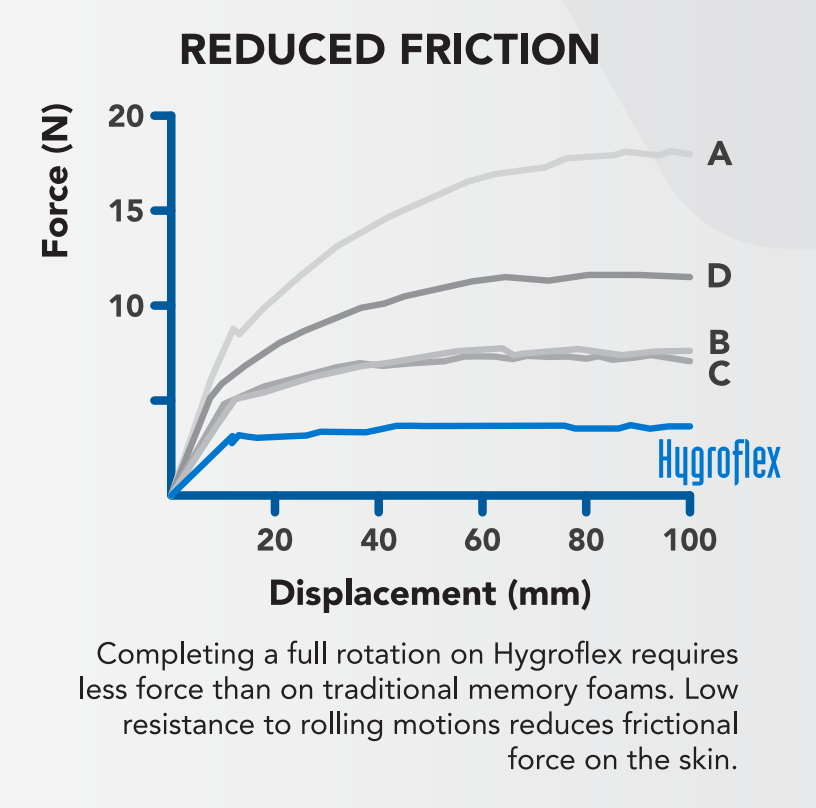Hygroflex Under RMIT’S Microscope
RMIT research proves Hygroflex provides more comfort and is more effective in reducing pressure sores than traditional memory foams.
For patients in hospital or at home, spending weeks, even months in bed, can result in uncomfortable pressure ulcers.
Pressure ulcers are also known as ‘bed sores’ or ‘lying down ulcers’. People are at risk of developing pressure ulcers when they can’t easily change position in bed.
Constant pressure or friction causes damage to the skin and underlying tissue. Pressure ulcers are a common problem for people with reduced mobility, especially aged care patients who are confined to a chair or bed.
Pressure ulcers are dangerous if left untreated. They can lead to serious conditions such as:
sepsis (bacteria entering the bloodstream)
cellulitis (inflammation of body tissue, causing swelling and redness)
bone and joint infections and more.
The RMIT Research
RMIT University recently conducted a study to determine the effectiveness of Joyce’s Hygroflex foam as a pressure redistribution material compared to traditional memory foams.
The researchers were interested in the properties of a pressure redistribution surface that helped mitigate the development of pressure ulcers.
Several mechanical tests were developed to evaluate the response of each foam type. These tests measured the pressure gradient, duration of pressure, immersion, envelopment, and shear and friction of the foam.
The Research Findings
1. Pressure Redistribution tests
Researchers developed three tests to measure the pressure redistribution capacity of Hygroflex against other foams.
They carried out a sharp indentation test to measure the foams’ ability to distribute pressure under a small, localised force.
They also performed a bulbous indentation test. This test quantified the foams’ ability to distribute pressure under a larger force.
Finally, they did an envelopment test to measure how well the various foams conform to the contours of the body.
The results of all three tests showed that Hygroflex is more effective at pressure redistribution than traditional memory foams. This indicates higher comfort levels and a lower risk of developing pressure ulcers when using Hygroflex as a support surface.
2. Heat Dissipation test
The researchers next applied a thermal diffusivity test. This test assessed how well heat disperses through the various foam samples.
Thermal diffusivity (α) measures the rate of heat transfer of a material from the hot side to the cold side of a surface.
In a material with high thermal diffusivity, ‘heat transfers rapidly through it because the substance conducts heat quickly relative to its volumetric heat capacity or ‘thermal bulk’’.
The results of the thermal test show that heat generated from the body diffuses through Hygroflex faster than through traditional memory foams.
The high thermal diffusivity of Hygroflex helps maintain lower local skin temperatures, important in preventing pressure ulcers. High thermal diffusivity also helps keep a mattress cool and dry, supporting a more comfortable sleep.
3. Shear and Friction tests
Several tests were developed to measure Hygroflex’s resistance to movement.
The researchers performed a shear test. This test assessed the strength of the various foam samples and their ability to move in lateral and sliding motions.
To help measure the force required for a patient immersed in foam to roll over, the RMIT team carried out a roller-arm test.
A cyclic test was also performed to measure the foams’ resistance to rolling motions and their energy absorption.
The test results show that moving and rotating on Hygroflex requires minimal force. In fact, the force required was less than half of that needed when using conventional memory foams.
Low resistance to rolling motions allows easy movement on the mattress, which has been linked to higher comfort levels and better sleep efficiency [Shen et al.]. This also helps reduce frictional stress on the skin.
The Research Conclusions
The research results indicate that Hygroflex has several pressure ulcer mitigation properties:
Hygroflex can redistribute pressure more effectively than traditional memory foams.
Hygroflex can diffuse body heat more rapidly than traditional memory foams.
Moving on Hygroflex requires less force and generates less friction.
These results suggest higher levels of comfort and a lower risk of developing pressure ulcers when using Hygroflex as a support surface.
For more information or your own copy of the full report, please contact Joyce Foam Products by email sales@joyce.com.au or call 1800 021 304.



